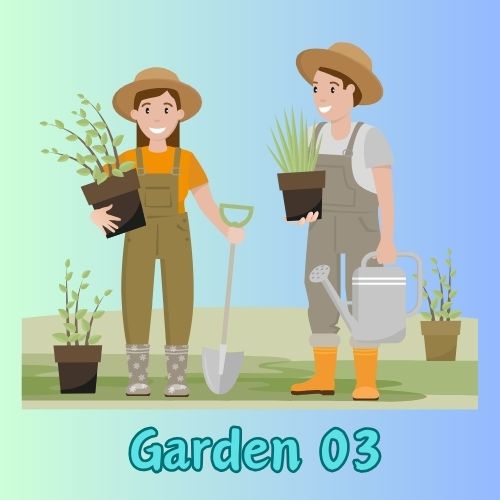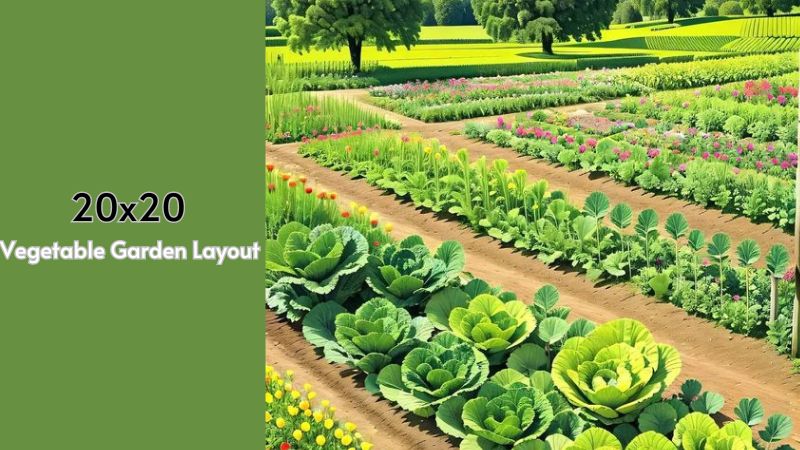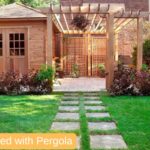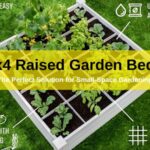Creating a 20×20 vegetable garden layout can be an exciting and rewarding project. Whether you’re an experienced gardener or just starting out, Garden 03 will walk you through everything you need to know to design and plan an efficient and productive vegetable garden in a 20×20-foot space. With the right layout, you can maximize your garden’s potential, grow a variety of vegetables, and enjoy fresh produce right from your backyard.
Why a 20×20 Garden Layout is Ideal for Home Gardeners
A 20×20-foot garden provides plenty of space for growing vegetables while remaining manageable for home gardeners. With 400 square feet of space, you can grow a wide variety of vegetables, including root crops, leafy greens, legumes, and fruiting plants, without feeling overwhelmed by maintenance. This size also allows for crop rotation, companion planting, and succession planting, ensuring that your garden remains productive throughout the growing season.
Here are some reasons why a 20×20 vegetable garden layout is ideal:
- Diverse Planting Options: A 20×20 garden offers enough space for multiple types of vegetables, allowing you to experiment with different varieties and grow a diverse range of crops.
- Manageable Size: At 400 square feet, this garden size is large enough to produce significant yields but small enough to manage without needing professional gardening help.
- Flexibility: A 20×20 layout can accommodate raised beds, traditional in-ground planting, container gardening, or a combination of these methods.
- Maximized Harvest: With the right layout, you can ensure proper spacing, sunlight, and water distribution, which translates to healthier plants and larger yields.
Planning Your 20×20 Vegetable Garden Layout
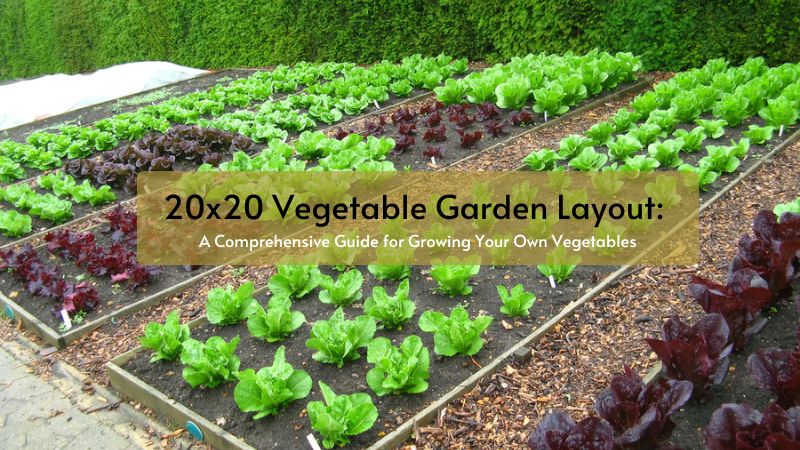
Before you start planting, it’s essential to plan your garden layout. Proper planning can help you make the best use of the space, ensure your plants receive adequate sunlight, and prevent issues like overcrowding and poor drainage.
1. Assess the Garden Site
The first step in designing your 20×20 vegetable garden layout is to evaluate your garden site. The following factors are crucial to consider:
- Sunlight: Most vegetables require at least 6-8 hours of direct sunlight per day. Choose a location that gets plenty of sun, especially during the early morning and afternoon.
- Soil Quality: Test your soil to determine its pH level and nutrient content. Amending the soil with compost or organic matter will improve its fertility and structure, making it more conducive for growing vegetables.
- Water Access: Ensure that your garden is located near a water source, such as a hose or irrigation system, to make watering your plants more convenient.
- Drainage: Good drainage is essential for vegetable growth. If your garden site is prone to waterlogging, consider using raised beds or amending the soil with sand or organic matter to improve drainage.
2. Choose Your Vegetables
Selecting the right vegetables for your garden is key to creating a successful layout. When choosing vegetables, consider the following:
- Climate and Growing Season: Choose vegetables that are suitable for your growing zone. Cool-season crops like lettuce, spinach, and peas are great for early spring and fall planting, while warm-season crops like tomatoes, peppers, and cucumbers thrive in the summer.
- Companion Planting: Certain vegetables grow better together, while others should be kept apart. For example, planting tomatoes with basil or carrots can improve growth, but avoid planting tomatoes near potatoes.
- Vertical Gardening: If space is limited, consider growing climbing vegetables like beans, peas, or cucumbers on trellises to maximize space.
3. Design the Garden Beds
There are several types of garden beds you can choose from when designing your 20×20 vegetable garden layout. Each has its own benefits and may work better for different types of gardens:
- Traditional Rows: A common garden layout is to plant vegetables in long, straight rows with pathways in between. This method works well for larger gardens and provides easy access to your plants.
- Raised Beds: Raised beds are elevated garden beds that provide better drainage and soil quality. They’re also easier to manage and reduce the need for bending and kneeling while gardening.
- Square Foot Gardening: This method involves dividing your garden into square-foot sections and planting specific crops in each square. Square foot gardening maximizes space and minimizes waste, making it ideal for smaller areas.
- Companion Planting Layout: Grouping companion plants together can improve growth and deter pests. For example, planting marigolds among your vegetables can help repel harmful insects.
4. Map Out the Layout
Once you’ve chosen your vegetables and garden bed type, it’s time to map out the layout. Consider the following tips:
- Group Plants by Water and Sunlight Needs: Place vegetables with similar water and sunlight requirements together to make maintenance easier.
- Use Vertical Space: Grow climbing plants like beans and peas on trellises along the garden’s edge to save ground space for other vegetables.
- Leave Walkways: Ensure there’s enough space between rows or beds for you to walk through the garden without damaging your plants. Typically, 18-24 inches is sufficient for pathways.
Here’s an example of how you might arrange your garden:
- Front Section (Sun-Loving Plants): Tomatoes, peppers, cucumbers, and eggplant
- Middle Section (Root Vegetables): Carrots, radishes, onions, and beets
- Back Section (Climbing Vegetables): Beans, peas, and squash on trellises
- Edges (Herbs and Companion Plants): Basil, parsley, marigolds, and nasturtiums
5. Rotation and Succession Planting
To keep your 20×20 vegetable garden productive throughout the season, consider rotation and succession planting:
- Crop Rotation: Rotate your crops each year to prevent soil depletion and reduce the risk of disease. For example, after growing tomatoes in one spot, plant a different crop like lettuce or carrots there the following year.
- Succession Planting: Stagger planting times so that you can harvest multiple crops in the same space over the course of the season. For instance, plant lettuce early in the spring, followed by beans or peppers in the summer.
Essential Tips for a Successful 20×20 Vegetable Garden Layout
Now that you have your garden layout planned, here are some additional tips to ensure success:
1. Soil Preparation and Fertilization
Healthy soil is the foundation of a productive vegetable garden. In a 20×20 garden, preparing the soil properly is critical to plant growth:
- Amend the Soil: Mix in organic matter such as compost or well-rotted manure to improve soil fertility and structure.
- Use Mulch: Applying mulch around your plants can help retain moisture, reduce weeds, and improve soil health.
- Fertilize Regularly: Vegetables are heavy feeders, so use organic fertilizers or compost tea to provide the necessary nutrients throughout the growing season.
2. Watering Techniques
Proper watering is essential to a thriving garden. Consider these watering techniques for a 20×20 vegetable garden:
- Drip Irrigation: This system delivers water directly to the plant’s root zone, minimizing evaporation and ensuring that your plants get the right amount of water.
- Soaker Hoses: Lay soaker hoses around your garden beds to provide consistent moisture to your vegetables without over-watering.
- Water Early in the Morning: Watering in the morning reduces the risk of fungal diseases and ensures that your plants have enough moisture to last through the heat of the day.
3. Pest and Disease Management
Protect your garden from pests and diseases to ensure a bountiful harvest. Here are some natural methods to keep your garden healthy:
- Companion Planting: Grow pest-repelling plants like marigolds, basil, or garlic alongside your vegetables to deter harmful insects.
- Beneficial Insects: Encourage beneficial insects like ladybugs and bees to your garden by planting flowers and avoiding chemical pesticides.
- Rotate Crops: Avoid planting the same crops in the same spot year after year to reduce the buildup of pests and diseases in the soil.
4. Maximizing Space and Yield
In a 20×20 garden, every square foot counts. Here are some strategies to maximize space and increase your harvest:
- Interplanting: Plant fast-growing crops like radishes between slower-growing plants like tomatoes or peppers. This allows you to harvest multiple crops in the same space.
- Vertical Gardening: Use trellises, cages, or stakes to grow vining crops upward, freeing up ground space for other plants.
- Succession Planting: Replant harvested areas with new crops to extend your growing season and increase your yield.
5. Harvesting and Storing Your Vegetables
Harvesting your vegetables at the right time ensures that they’re at their peak flavor and nutrition. Follow these tips for harvesting and storing your crops:
- Pick Regularly: Harvest vegetables like beans, cucumbers, and zucchini frequently to encourage continuous production.
- Use Proper Storage Methods: Store root vegetables like carrots and potatoes in a cool, dark place. Leafy greens can be refrigerated, and tomatoes should be kept at room temperature for the best flavor.
- Preserve Excess Produce: If you have more vegetables than you can eat fresh, consider preserving them through canning, freezing, or drying.
Sample 20×20 Vegetable Garden Layout Plan
Here’s a sample layout for a 20×20 vegetable garden designed for maximum yield and variety:
Front Section (Warm Season Crops)
- Tomatoes (4 plants): Space 3 feet apart
- Peppers (4 plants): Space 2 feet apart
- Eggplants (2 plants): Space 2 feet apart
- Cucumbers (2 plants): Grown on a trellis to save space
Middle Section (Root Vegetables and Leafy Greens)
- Carrots (2 rows): Plant seeds in rows 1 foot apart; thin seedlings to 2 inches apart
- Radishes (1 row): Space seeds 1 inch apart in rows, thin to 2 inches apart once sprouted
- Lettuce (2 rows): Space plants 8-12 inches apart
- Spinach (2 rows): Space plants 6 inches apart; successive sowings can extend harvest
Back Section (Climbing Vegetables and Legumes)
- Pole Beans (2 rows): Use trellises along the garden’s edge; space seeds 4-6 inches apart
- Peas (2 rows): Grow up trellises to save ground space
- Squash (1 plant): Use vertical space with a sturdy trellis to support the weight of the fruit
Edges (Herbs and Companion Plants)
- Basil (4 plants): Plant around tomatoes for flavor enhancement and to repel pests
- Parsley (4 plants): Plant near lettuce or carrots
- Marigolds (6 plants): Place at the garden’s borders to deter pests
- Nasturtiums (4 plants): Plant along the edges to attract beneficial insects and act as a pest trap
Walkways and Pathways
In this 20×20 vegetable garden layout, make sure to leave 18-24 inch-wide walkways between sections of the garden beds. This will allow you to easily navigate the garden for planting, watering, and harvesting without trampling your plants.
Conclusion
A well-designed 20×20 vegetable garden layout can provide an abundance of fresh produce for your family throughout the growing season. By carefully planning your garden, selecting the right crops, and employing techniques like succession planting and vertical gardening, you can make the most of your space and enjoy a productive, healthy garden year after year. Whether you’re growing tomatoes, carrots, beans, or herbs, a thoughtful layout and regular garden maintenance will ensure a bountiful harvest. So grab your gardening tools, start planning, and enjoy the rewards of your very own 20×20 vegetable garden!
